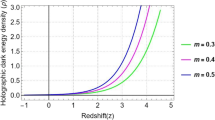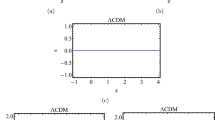Abstract
The purpose of this paper is to study the Tsallis agegraphic dark energy with an interaction term between dark energy and dark matter in the DGP brane-world scenario. For this, we assume some initial conditions to obtain the dark energy density, deceleration, dark energy EoS, and total EoS parameters. Then, we analyze the statefinder parameters, \(\omega '{}_{DE}-\omega _{DE}\) plots, and classical stability features of the model. The results state that the deceleration parameter provides the phase transition from decelerated to accelerated phase. The \(\omega _{DE}\) graphs show the phantom behavior, while the \(\omega _{tot}\) exhibits the quintessence and phantom during the evolution of the Universe. Following the graphs, the Statefinder analysis shows the quintessence behavior of the model for the past and present. However, it tends to the \(\Lambda CDM\) in the following era. The \(\omega '{}_{DE}-\omega _{DE}\) plot indicates the thawing or freezing area depending on the type of era and different values of \(b^{2}\), \(\delta \), and \(m\). By the square of the sound speed, we see the model is stable in the past, stable or unstable at the current time, and unstable in the future for selected values of \(b^{2}\), \(\delta \), and \(m\). To test the model, we use the recent Hubble data. We also employ Akaike Information Criterion (AIC) and Bayesian Information Criterion (BIC) to compare the model with the \(\Lambda CDM\) as the reference model. In addition, we test the model using the \(H-z\) plot, and we see a turning point in the future time. The results from the best fit values for the \(\omega _{tot}\) plot emphasize that the Universe is in the quintessence region in the current time. It will enter the phantom phase, and then it will approach the \(\Lambda \) state in the future. But, the \(\omega _{DE}\) always stays on the phantom region. The model is unstable in the present and progressive era.















Similar content being viewed by others
Data Availability
This manuscript has no associated data or the data will not be deposited.
References
Abdollahi Zadeh, M., Sheykhi, A., Moradpour, H., Bamba, K.: Eur. Phys. J. C 78, 940 (2018). https://doi.org/10.1140/epjc/s10052-018-6427-3
Abdollahi Zadeh, M., Sheykhi, A., Moradpour, H.: Mod. Phys. Lett. A 34, 1950086 (2019). 1810.12104
Akaike, H.: IEEE Trans. Autom. Control 19, 716–723 (1974). https://doi.org/10.1109/TAC.1974.1100705
Akama, A.: Lect. Notes Phys. 176, 0001113 (1982)
Amanullah, R., Lidman, C., Rubin, D., Aldering, G., Astier, P., Barbary, K., Burns, M.S., Conley, A., Dawson, K.S., Deustua, S.E.: Astrophys. J. 716, 712 (2010)
Amarilla, L., Eiroa, E.F.: Phys. Rev. D 85, 064019 (2012)
Amendola, L.: Phys. Rev. D 62, 043511 (2000). astro-ph/9908023
Anagnostopoulos, F.K., Basilakos, S., Saridakis, E.N.: Eur. Phys. J. C 80, 826 (2020)
Arévalo, F., Bacalhau, A.P.R., Zimdahl, W.: Class. Quantum Gravity 29, 235001 (2012). 1112.5095
Armendariz-Picon, C., Mukhanov, V.F., Steinhardt, P.J.: Phys. Rev. Lett. 85, 4438 (2000)
Astier, P., Guy, J., Regnault, N., Pain, R., Aubourg, E., Balam, D., Basa, S., Carlberg, R.G., Fabbro, S., Fouchez, D., Hook, I.M., Howell, D.A., Lafoux, H., Neill, J.D., Palanque-Delabrouille, N., Perrett, K., Pritchet, C.J., Rich, J., Sullivan, M., Taillet, R., Aldering, G., Antilogus, P., Arsenijevic, V., Balland, C., Baumont, S., Bronder, J., Courtois, H., Ellis, R.S., Filiol, M., Gonçalves, A.C., Goobar, A., Guide, D., Hardin, D., Lusset, V., Lidman, C., McMahon, R., Mouchet, M., Mourao, A., Perlmutter, S., Ripoche, P., Tao, C., Walton, N.: Astron. Astrophys. 447, 31–48 (2006)
Barrow, J.D.: Phys. Lett. B 808, 135643 (2020). https://doi.org/10.1016/j.physletb.2020.135643
Bean, R.: Phys. Rev. D 64, 123516 (2001)
Bean, R., Magueijo, J.: Phys. Lett. B 517, 177 (2001). astro-ph/0007199
Cai, R.G.: Phys. Lett. B 657, 228 (2007)
Caldwell, R.R.: Phys. Lett. B 545, 23 (2002)
Caldwell, R.R., Linder, E.V.: Phys. Rev. Lett. 95, 141301 (2005)
Chimento, L.P., Richarte, M.G.: Phys. Rev. D 85, 127301 (2012)
Colgaín, E.O., Sheikh-Jabbari, M.M.: Class. Quantum Gravity 38, 177001 (2021)
Copeland, E.J., Liddle, A.R., Wands, D.: Phys. Rev. D 57, 4686 (1998). gr-qc/9711068
Copeland, E.J., Sami, M., Tsujikawa, S.: Int. J. Mod. Phys. D 15, 1753 (2006a)
Copeland, E.J., Sami, M., Tsujikawa, S.: Int. J. Mod. Phys. D 15, 1753 (2006b). hep-th/0603057
Das, S., Corasaniti, P.S., Khoury, J.: Phys. Rev. D 73, 083509 (2006). astro-ph/0510628
Deffayet, C.: Phys. Lett. B 502, 199–208 (2001). hep-th/0010186
Deffayet, C., Dvali, G.R., Gabadadze, G.: Phys. Rev. D 65, 044023 (2002). astro-ph/0105068
Dvali, G.R., Gabadadze, G., Porrati, M.: Phys. Lett. B 485, 208 (2000a)
Dvali, G., Gabadadze, G., Porrati, M.: Phys. Lett. B 485, 208 (2000b). hep-th/0005016
Ebrahimi, E., Golchin, H., Mehrabi, A., Movahed, S.M.S.: Int. J. Mod. Phys. D 26, 1750124 (2017). https://doi.org/10.1142/S0218271817501243
Farrar, G.R., Peebles, P.J.E.: Astrophys. J. 604, 1 (2004). astro-ph/0307316
Ghaffari, S., Dehghani, M.H., Sheykhi, A.: Phys. Rev. D 89, 123009 (2014)
Ghaffari, S., Moradpour, H., Bezerra, V.B., Morais Graça, J.P., Lobo, I.P.: Phys. Dark Universe 23, 100246 (2019)
Gumjudpai, B.: Gen. Relativ. Gravit. 36, 747–766 (2004). https://doi.org/10.1023/B:GERG.0000016922.72972.67
Holden, D.J., Wands, D.: Phys. Rev. D 61, 043506 (2000). gr-qc/9908026
Honarvaryan, M., Sheykhi, A., Moradpour, H.: Int. J. Mod. Phys. D 24, 1550048 (2015). https://doi.org/10.1142/S0218271815500480
Hu, B., Ling, Y.: Phys. Rev. D 73, 123510 (2006)
Huang, Q., Huang, H., Xu, B., Tu, F., Chen, J.: Eur. Phys. J. C 81, 686 (2021). https://doi.org/10.1140/epjc/s10052-021-09480-3
Jamil, M., Saridakis, E.N.: J. Cosmol. Astropart. Phys. 1007, 028 (2010). 1003.5637
Jawad, A., Rani, S., Salako, I.G., Gulshan, F.: Eur. Phys. J. Plus 131, 236 (2016). https://doi.org/10.1140/epjp/i2016-16236-x
Kamenshchik, A.Y., Moschella, U., Pasquier, V.: Phys. Lett. B 511, 265 (2001)
Lee, S., Liu, G.-C., Ng, K.-W.: Phys. Rev. D 73, 083516 (2006). astro-ph/0601333
Liu, X.-L., Zhang, X.: Commun. Theor. Phys. 52, 761–768 (2009). 0909.4911
Maartens, R., Koyama, K.: Living Rev. Relativ. 13, 5 (2010). https://doi.org/10.12942/lrr-2010-5
Moradpour, H., Corda, C., Ziaie, A.H., Ghaffari, S.: Europhys. Lett. 127, 60006 (2019)
Moresco, M., Pozzetti, L., Cimatti, A., Jimenez, R., Maraston, C., Verde, L., Thomas, D., Citro, A., Tojeiro, R., Wilkinson, D.: J. Cosmol. Astropart. Phys. 05, 014 (2016). 1601.01701
Pavon, D., Zimdahl, W.: Phys. Lett. B 628, 206 (2005). https://doi.org/10.1016/j.physletb.2005.08.134
Peebles, P.J.E., Ratra, B.: Rev. Mod. Phys. 75, 559 (2003)
Perlmutter, S., Aldering, G., Goldhaber, G., Knop, R.A., Nugent, P., Castro, P.G., Deustua, S., Fabbro, S., Goobar, A., Groom, D.E.: Astron. J. 517, 565 (1999)
Planck Collaboration: Astron. Astrophys. 641, A6 (2020). https://doi.org/10.1051/0004-6361/201833910
Randall, L., Sundrum, R.: Phys. Rev. Lett. 83, 3370 (1999a)
Randall, L., Sundrum, R.: Phys. Rev. Lett. 83, 4690 (1999b)
Rani, S., Azhar, N.: Universe 7, 268 (2021). https://doi.org/10.3390/universe7080268
Riess, A.G., Filippenko, A.V., Challis, P., Clocchiatti, A., Diercks, A., Garnavich, P.M., Gilliland, R.L., Hogan, C.J., Jha, S., Kirshner, R.P.: Astron. J. 116, 1009 (1998)
Riess, A.G., Kirshner, R.P., Schmidt, B.P., Jha, S., Challis, P., Garnavich, P.M., Esin, A.A., Carpenter, C., Grashius, R., Schild, R.E.: Astrophys. J. 117, 707 (1999)
Saaidi, K., Sheikhahmadi, H., Mohammadi, A.H.: Astrophys. Space Sci. 338, 355–361 (2012). 1201.0275
Sadeghi, J., Khurshudyan, M., Movsisyan, A., Farahani, H.: J. Cosmol. Astropart. Phys. 12, 031 (2013)
Sadri, E.: Eur. Phys. J. C 79, 762 (2019). https://doi.org/10.1140/epjc/s10052-019-7263-9
Sadri, E., Khurshudyan, M.: Int. J. Mod. Phys. D 28, 1950152 (2019). 1809.07595
Sahni, V., Starobinsky, A.A.: Int. J. Mod. Phys. D 9, 373 (2000)
Sahni, V., Saini, T.D., Starobinsky, A.A., Alam, U.: JETP Lett. 77, 201–206 (2003). https://doi.org/10.1134/1.1574831
Salvatelli, V., Said, N., Bruni, M., Melchiorri, A., Wands, D.: Phys. Rev. Lett. 113, 181301 (2014). 1406.7297
Schwarz, G.: Ann. Stat. 6, 461–464 (1978). https://doi.org/10.1214/aos/1176344136
Shababi, H., Ourabah, K.: Eur. Phys. J. Plus 135, 697 (2020). https://doi.org/10.1140/epjp/s13360-020-00726-9
Sheykhi, A., Wang, B.: Mod. Phys. Lett. A 25, 1199 (2010)
Sheykhi, A., Sadegh Movahed, M., Ebrahimi, E.: Astrophys. Space Sci. 339, 93–99 (2012). https://doi.org/10.1007/s10509-012-0977-x
Sheykhi, A., Dehghani, M.H., Hosseini, S.E.: Phys. Lett. B 726, 23 (2013)
Sheykhi, A., Dehghani, M.H., Ghaffari, S.: Int. J. Mod. Phys. D 25, 1650018 (2016). 1506.02505
Srivastava, Sh., Dubey, V.C., Sharma, U.K.: Int. J. Mod. Phys. A 35, 2050027 (2020)
Srivastava, S., Sharma, U., Dubey, V.: Gen. Relativ. Gravit. 53, 47 (2021). https://doi.org/10.1007/s10714-021-02818-y
Tsallis, C., Cirto, L.J.L.: Eur. Phys. J. C 73, 2487 (2013). 1202.2154
Uzan, J.-P.: Phys. Rev. D 59, 123510 (1999). gr-qc/9903004
Wang, B., Zang, J., Lin, C.-Y., Abdalla, E., Micheletti, S.: Nucl. Phys. B 778, 69 (2007). https://doi.org/10.1016/j.nuclphysb.2007.04.037
Wei, H., Cai, R.G.: Phys. Lett. B 660, 113 (2008a)
Wei, H., Cai, R.-G.: Phys. Lett. B 663, 1–6 (2008b). 0708.1894
Xu, Y.D.: Commun. Theor. Phys. 72, 015402 (2020). https://doi.org/10.1088/1572-9494/ab544e
Acknowledgements
I would like to appreciate the significant comments by the brilliant reviewers that made many improvements to this manuscript. Thank you so much.
Funding
This research received no funding.
Author information
Authors and Affiliations
Corresponding author
Ethics declarations
Conflict of Interest
The author declares that she has no conflict of interest.
Additional information
Publisher’s Note
Springer Nature remains neutral with regard to jurisdictional claims in published maps and institutional affiliations.
Rights and permissions
About this article
Cite this article
Feizi Mangoudehi, Z. Interacting Tsallis agegraphic dark energy in DGP braneworld cosmology. Astrophys Space Sci 367, 31 (2022). https://doi.org/10.1007/s10509-022-04044-7
Received:
Accepted:
Published:
DOI: https://doi.org/10.1007/s10509-022-04044-7




